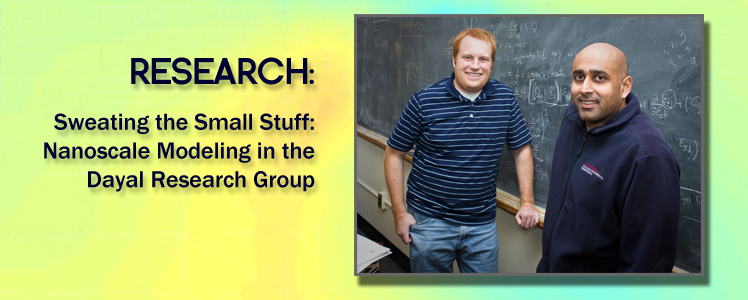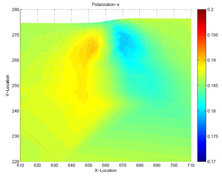
 Graphic shows deformation and polarization of an atomisitic ferroelectric material subjected to applied electric fields. Results come from new multiscale method for electromechanical materials developed by Jason Marshall and Kaushik Dayal
Graphic shows deformation and polarization of an atomisitic ferroelectric material subjected to applied electric fields. Results come from new multiscale method for electromechanical materials developed by Jason Marshall and Kaushik Dayal
Most of the materials being studied in the Kaushik Dayal research group cannot be seen with the naked eye, but that doesn’t mean he can’t get excited about it. Dayal, an assistant professor in CEE’s Mechanics, Materials, and Computing division, studies the behavior of electromechanical and electrochemical materials, or materials that interact with electricity in fascinating ways. His group’s current research, funded by the Army Research Office, focuses on understanding the physics behind atom-to-atom interactions at the nanoscale level, and has the potential to change the way we power our vehicles and our cities.
Dayal and PhD candidate Jason Marshall are working to develop a computer method to predict the behavior of electromechanical and electrochemical materials at the nanoscale. This method would provide researchers with valuable information about how these materials act under mechanical stress and electrical loadings. Marshall hopes that their work will deepen researchers’ understanding of the structures of these materials. “A lot of interesting things happen with these materials at the nanoscale, butnot a lot is known about the underlying physics,” he explained. “If you look at a steel beam, for example, you might assume that steel is homogenous, or unchanging. But when you go down to the atomic level, the material structures are constantly moving and changing, and you see impurities and defects that you just don’t see at larger scales. We’re working to incorporate those structural defects into a model so researchers can understand more about the structure of materials at the atomic level.”
The Dayal group's approach to materials modeling is a unique one. Marshall explained that their model represents the next step in the evolution of nanoscale models. “The challenge in modeling atoms is that any type of device you’re designing contains trillions of atoms. Current models trying to predict the behavior of various materials assume that atoms only engage in short-range interactions with atoms very near to them. But in the materials that we’re interested in, every atom interacts with every other atom in the system, and you can’t represent that using current models. So we’ve found a way to include these long-range interactions in our model, and better yet, our model works in conjunction with the existing short-range interaction models.” A further advantage of their model is its universality; because all electromechanical and electrochemical crystalline materials share certain features, the Dayal group’s model is able to predict the behavior of almost any of these crystalline materials based on those common features.
Once researchers are presented with a way to model these complex materials, they can devise creative ways to use them. The research being conducted by the Dayal group has numerous valuable applications; in particular, it could transform next-generation battery technology. Dayal explained, “Batteries have been optimized in the last twenty years for personal electronics, but those batteries were engineered with small items in mind. Big batteries are not very efficient; the more space between the two ends of a battery, the harder it is to quickly get energy out of it. So one of the ideas being studied in nanotechnology today is making a very small battery, about a nanometer [one millionth of a millimeter] long, and lining it up with billions of others of its kind to form a battery that can quickly provide energy.” Armed with a model that explains how the materials they are manipulating will behave, experimentalists could successfully optimize battery technology for use in hybrid cars and more. Dayal noted that while the concept of nanoscale battery production has been around for decades, it took quite a lot to come together. “In a sense, technology is converging with what people want.”
The Dayal group’s work on materials modeling could also have applications in large-scale energy harvesting. Intermittent power sources such as solar power may benefit from being able to store excess energy in large batteries when the sun shines in the daytime, and using the stored energy at night when it is in demand. Their model could also provide insight in the field of new material development. “Experimentalists are frequently combining materials at different composition levels to see what happens, but it’s very costly to do that experimentally,” Marshall explained. “If we can test some of those combinations using a computer model, it’s much cheaper and more effective.”
Dayal became interested in the field of nanotechnology while completing his graduate studies at the California Institute of Technology. He described his research as a perfect blend of engineering and science, and offered a simple summary of his approach: “We’re saying, these materials can be used to make more efficient batteries, so let’s figure out how they behave in weird situations. Then, the people developing the batteries can use our findings to improve the technology.” Dayal and Marshall are in the process of assembling their findings into a paper, which they plan to submit to an engineering journal.
Dayal’s contributions to the field have not gone unnoticed. In 2012, he was honored with the Army Research Office Young Investigator Award, the Air Force Office of Scientific Research Young Investigator Prize, and the National Science Foundation CAREER Award. Marshall has also been recognized for his hard work; he received the Best Poster Award at the 2011 U.S. National Congress on Computational Mechanics for his poster describing his modeling research, and was awarded the CIT Northrop Fellowship in the same year. He shares Dayal’s enthusiasm about the research. “As a PhD student working with him, I have the freedom and the ability to pursue the things I’m most interested in, namely computations.”
Dayal framed his group’s research as a key step toward energy efficiency, saying, “We need to move away from carbon, especially coal, as our sole energy source. Batteries are going to be important, and these materials are going to be important for batteries. It is the perfect time to advance these technologies.”
Please visit Professor Dayal's Website for more information about his research